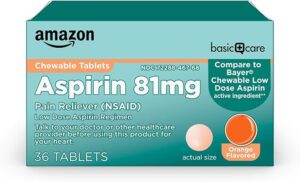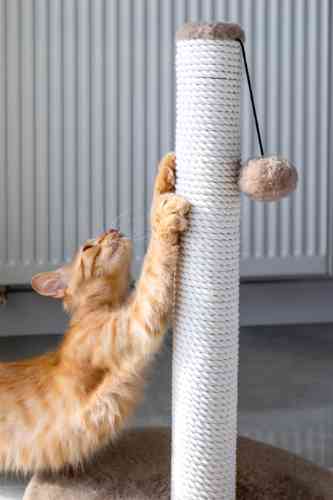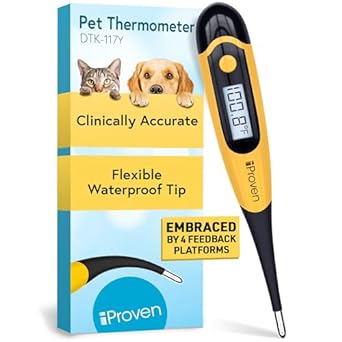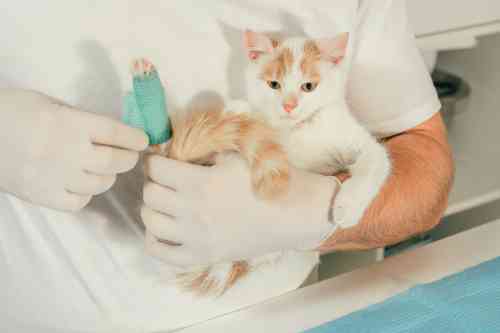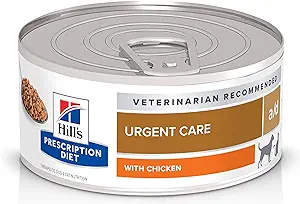Your cat is limping
What can you do about it?
Your cat is limping and you are worried about it. Should you go to your vet now or can you just wait and see? And what can you do to help your cat with his limp if you decide to wait it out. In this article we will explain how to determine whether your cat is limping due to a broken leg or it is just a mild bruise. We will tell you more about osteoarthritis and when it is best to visit a vet. Depending on the cause of your cat’s limping, we will give you possible treatments and other tips to suppress your cat’s pain. This will cause him to have less pain when walking and reduce his limping. Hopefully you will benefit from this article in order to help your cat.
Why does a cat limp?
If your cat limps, he will feel an uncomfortable sensation in his paw while he uses it. In order not to feel this uncomfortable feeling, he will use his paw in a different way than you are used to from him. For example, he will hold his paw in the air and walk on 3 legs. Or he puts it on the ground, but tries to rest on it as little as possible. You will then see a hop in its walk. During these hops he pushes off with his other leg so that less weight is placed on the lame leg and it hurts less. He may also have an ingrown nail, for example. In that case, he will place his foot crookedly and place it more inwards or outwards. With these special positions your cat can minimise pain while walking.
What can I do if my cat is limping?
Veterinarian or wait and see what happens?
If your cat is limping very badly and is therefore in a lot of pain, it is best to go to your vet for further examination. Is your cat not limping excessively and is he otherwise behaving normally? Does he still walk around your house and eat well? Then you can also wait and see what happens to it for a few days. In most cases, the limp has improved a lot within about 2-3 days and is completely gone again within a week at the latest.
It is wise to examine your cat’s paw yourself, if he allows you to do so. His lame, painful leg should not feel much warmer than his healthy leg. He should not have ingrown nails (otherwise you should cut them off as soon as possible). And you can gently bend and stretch his leg at each joint to see if he has any pain in any joint. This way you will know exactly where the pain is in his leg. There should also be no wounds to be felt or seen. Don’t forget to also examine the pads of his feet carefully. It is possible that there is a cut in the pad of his foot that is causing your cat to limp.
Limit his movement
Try to prevent your cat from using its paw as much as possible. For example, provide an extra stool if he wants to jump on something high and try to see if he wants to stay at home instead of going out to play. Also limit playing with other cats as this can get quite busy at times.
Painkiller
It would of course be nice if your cat could also receive a painkiller. Unfortunately, you can only get this if you take your cat to the vet. Painkillers for humans are almost all toxic to cats. The only exception is Aspirin. Your cat may receive a half of a tablet of a 81mg aspirin tablet once every 2 days (so NOT 2x a day!!). YOUR CAT SHOULD NOT BE GIVEN PARACETAMOL OR IBUPROFEN OR ANYTHING OTHER THAN ASPIRIN BECAUSE IT WILL KILL YOUR CAT! Only aspirin is suitable for your cat. The fact that your cat can only have this once every 2 days is because aspirin disappears from the body very slowly in cats. They lack a certain mechanism to remove drugs from their bodies. But it is better to take him to your vet and take a painkiller suitable for cats.
Hemp-oil
If you prefer to provide your cat with a natural painkiller, you can use CBD oil. You can use this for the short term, but you can also use it in the long term. It has an anti-inflammatory and analgesic effect. In addition, it also calms your cat if he is very stressed due to pain. You can start by giving 2 drops twice a day, but you can increase this to a maximum of 10 drops per day.
Your cat is limping but not in pain
As veterinarians, we hear this very often. Really very often! “My cat is limping but not in pain.” Unfortunately it is not correct. Your cat does experience pain or at least an uncomfortable feeling in his paw when he limps. He just won’t tell you if you examine his paw. If your cat has a paw that is really painful, he will certainly let you know if you hurt him when you examine his paw.
But with mild pain, a cat may not respond when you examine its paw. After all, he trusts you and knows that you are not consciously hurting him. And he might even know that you’re trying to help him. You think he isn’t in pain, but he really is. Otherwise, he will not decide to walk in a different way. After all, this takes quite a lot of extra energy and thinking for your cat. Your cat doesn’t do that for fun. But you can say that his pain is not too intense in this case.
How do you know if your cat is in pain when limping?
If your cat is limping, he is in pain. This can be very mild from a small wound to extremely painful with a broken leg. It’s not so much about knowing whether your cat is in pain, but how much pain it is in. You want to know how bad his pain is and whether he can heal the cause himself. And we will try to help you with that in this article.
What other symptoms can you see if your cat is limping?
In addition to limping in your cat, you may also notice the following symptoms:
- He does less activities because it hurts to walk
- Your cat may eat less. This may be because it hurts to walk to the food bowl. But it is also possible that your cat has a fever and is therefore less hungry.
- There may be several small wounds on his body if he has been in a fight or a collision
- Your cat’s nails may be ingrown, causing visible wounds in the pads of his feet
- In the event of a collision or fight, his nails may have been abraded. The nails then have frayed ends.
- Swelling may be visible on his paw
- Your cat may lick or bite excessively at the area of the paw that hurts him.
- Jumping becomes more difficult or even impossible.
- Your cat may lie down in a different way than you are used to to relieve the pain.
Your cat limps but still jumps on furniture
If your cat still jumps when limping, that is a good sign. The pain he feels is not extreme. For your cat, the advantage of jumping outweighs the disadvantage of the pain. The chance that something very serious is going on with his leg and causing the limp is very small. After all, you’re probably not going to jump on a table or scratch your nails on a scratching post with a broken leg.
These are usually the cats that do not respond to anything when touching their paw. And so you could possibly think that he is not in pain. He does experience an uncomfortable feeling in his lame leg, but it is not so extreme that further investigation by your veterinarian needs to be done immediately. You can just watch this for a week and see if he will heal on its own.
Your cat walks on 3 legs
Does your cat walk on 3 legs? Then it really hurts him. We see this with some regularity. In most cases when a cat walks on 3 legs, your cat has an abscess on its leg. But the chance of a serious bruise or even a broken leg is certainly not small. It is best to carefully examine the leg and see if you see a wound, no matter how small.
It is also wise to measure whether your cat has a fever. Does he have a fever (his body temperature is higher than 39.5 degrees) and do you see a small wound? Then there is a good chance that he has an abscess. Is there no fever? Then there is a chance of a bruise or broken leg and it is best to take him to your vet. He can then decide whether it is necessary to conduct further research in the form of an X-ray of his leg to rule out a fracture.
Your cat limps after sleeping
If your cat limps when he has just been sleeping, we call this “starting lameness”. In this case, there is usually muscle pain or mild bruising. Older cats can also suffer from osteoarthritis. This means that his joint cartilage is worn out and an inflammation of your cat’s joints happend. You can wait and see what happens with this form of limping in your cat for a week or two. After that it should really be gone. Isn’t this the case? Then a visit to your vet is wise because your cat may need painkillers to combat inflammation. Painkillers are also anti-inflammatories. You can only get painkillers for a cat through your vet.
Your cat is limping after a fall
If your cat has fallen, it may have landed in the wrong place during its fall. He may have suffered a mild bruise or a seriously broken leg. Does your cat walk on 3 legs? Then it is best to take him to your vet to find out what is causing the pain that causes the limp. Does he just walk on all fours and doesn’t seem to be in excessive pain? Then he just suffered a mild bruise. Very annoying, but your cat’s body will resolve this automatically. It usually goes away within a week at the latest. Is there still no recovery after two weeks? Then you better take him to your vet.
When should you go to your vet if your cat is lame?
We’ve written it from time to time. But you should definitely take your cat to your vet if he is not putting any weight on his paw. So if he walks on 3 legs. Even if his leg is in a strange position, it is wise to do this, because it could be broken.
In addition, a cat can become very ill if it eats poorly. He could get a fatty liver from it, which can be lethal to a cat. So make sure that your cat gets nutrition. Place it next to him if it hurts to walk to his food bowl. Does he really not want to eat? Force feed him! And take him to your vet. This can give him medication that will help him eat better. And of course he can immediately see what is wrong with his paw.
Your cat limps and sleeps a lot
We mainly see this in very old cats that suffer from osteoarthritis. Their joints can be inflamed and worn out, causing them to have a lot of pain when walking and to become sleepier due to the inflammatory substances in their blood. You also often notice that these cats no longer take good care of themselves. This makes their coat feel greasy and the dead hair is no longer removed. Your cat will generally look a bit filthy.
Symptoms of osteoarthritis worsen during periods when the air is a lot more humid. So in spring and autumn it is the worst for them because it can be quite wet due to rain. In summer and cold winter, their pain symptoms are generally less severe. Unfortunately, osteoarthritis can’t be cured. But you can reduce the pain by giving your cat Flexadin daily. This ensures that he has less inflammation in his joints and a better structure of his cartilage. It also has a mild analgesic effect.
Your cat will probably walk around more smoothly and jump a little easier again in a month. However, if he continues to limp badly, it is wise to visit your vet. This can confirm whether it is indeed osteoarthritis and prescribe your cat a painkiller. He will probably have to get this for the rest of his life to be able to enjoy his life.
Your cat is limping and no longer eating
If your cat is limping and not eating, he may not want to walk to his food bowl because it hurts him too much. In that case, you can leave his food and water with him so he doesn’t have to make any effort. Your cat will probably eat again. If this is the case and your cat does not appear to have any extreme pain in its paw, you can wait for a day or two. After that he really has to start walking around more.
However, it is also possible that your cat is limping because he has an abscess on his leg. This is an infection under his skin, in this case on his paw, which causes him a lot of pain. However, the infection also causes a fever and the fever makes him feel less like eating. In this case it is wise to take him to your vet. After all, cats can’t handle a day without eating and can develop fatty liver disease as a result. This can be fatal.
Your vet will examine your cat and give him the appropriate treatment. If there is indeed an abscess on his paw, your vet will open the abscess and give your cat an antibiotic treatment and painkiller to take at home. The fever will then decrease during the day, causing your cat to eat better again. In the meantime, you can also provide him with extra tasty wet food that he can lick up like soup.
Your cat limps after fighting
If your cat is limping after fighting, there are two possibilities. First of all, your cat may have used all his muscles during his fight and is now quite sore. This usually occurs within about 3 hours after the fight. In that case, it will resolve itself after 2-3 days.
However, did you know that your cat had a fight 2 days ago and was he walking normally at first and only now limping? Then there is most likely an abscess on his leg. During the fight, the nail or tooth of the other cat (or dog) has dug into your cat’s skin. And at that moment a bacteria from that nail or tooth has gotten under your cat’s skin. It was only a very small wound, so you probably didn’t notice it. But the bacteria under the skin will multiply and your cat’s body will send pus cells there to attack that bacteria. It just doesn’t work out very well. So a lot of pus cells are needed. And those pus cells and bacteria combine to form a cavity under the skin that is filled with pus.
How long can a cat limp?
-
- If your cat is not limping too badly, you can watch it for a week. During that week he must of course not start to limp more and he must otherwise behave normally. So he must eat well and be cheerful and not appear sick. If he has not improved significantly after a week, it is better to take him to your vet. This person can try to find out what is going on and consider whether it is necessary to have further research done, for example in the form of an X-ray.
Hopefully your cat will be back to normal soon
We hope that the information on this page has answered your questions. Your cat deserves to be able to walk around your house pain-free again soon and cause chaos. Good luck to your cat and good luck to you with his care. He will probably be back to normal soon, with your tender-loving-care.



